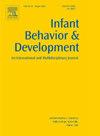Emerging sensitivity to talking mouth in infants with low and elevated likelihood of autism spectrum disorder: A longitudinal study
IF 1.9
3区 心理学
Q3 PSYCHOLOGY, DEVELOPMENTAL
引用次数: 0
Abstract
The talker’s mouth provides significant multimodal information that supports language development. Studies have revealed that infants over 6 months of age show increased attention to the mouth of a talking face, which results in vocabulary growth. However, few studies have reported the relationship between early gaze behavior and later language development in infants with an elevated likelihood of autism spectrum disorder (ASD) (EL infants). Since ASD cannot be diagnosed in infancy, these infants provide a valuable opportunity to investigate early developmental differences in visual attention that may be associated with ASD. Therefore, we conducted a longitudinal eye-tracking experiment at ages 6, 9, 12, 18, and 24 months to investigate differences in gaze behavior between infants with a low likelihood of ASD (LL infants) and EL infants. We found that, exclusively in LL infants, the proportion of mouth-looking time significantly increased from 6 months to 9 months of age and remained relatively constant thereafter. In contrast, in EL infants, although the proportion of mouth-looking time gradually increased with age up to 24 months, their attentional change to talking mouth started later than that in LL infants. Furthermore, our results showed a conditionally positive relationship between mouth-looking and expressive vocabulary size in LL infants but not in EL infants. These findings indicate that EL infants may not utilize audiovisual information as valuable cues for language acquisition during infancy and toddlerhood, which may be a factor in their slow language development.
自闭症谱系障碍低可能性和高可能性婴儿对说话嘴的新兴敏感性:一项纵向研究
说话者的嘴提供了重要的多模态信息,有助于语言发展。研究表明,6 个月以上的婴儿对说话者的嘴的注意力会增加,从而促进词汇量的增长。然而,对于自闭症谱系障碍(ASD)可能性较高的婴儿(EL 婴儿),很少有研究报告其早期注视行为与日后语言发展之间的关系。由于自闭症谱系障碍无法在婴儿期确诊,因此这些婴儿为研究可能与自闭症谱系障碍有关的视觉注意力早期发育差异提供了宝贵的机会。因此,我们对 6、9、12、18 和 24 个月大的婴儿进行了纵向眼动追踪实验,以研究 ASD 可能性较低的婴儿(LL 婴儿)和 EL 婴儿的注视行为差异。我们发现,仅在 LL 婴儿中,从 6 个月大到 9 个月大时看嘴的时间比例明显增加,之后则保持相对稳定。相比之下,虽然 EL 婴儿的看嘴时间比例随着年龄的增长逐渐增加,直至 24 个月大,但他们对说话嘴的注意力变化开始得比 LL 婴儿晚。此外,我们的研究结果表明,LL 婴儿的看嘴时间与表达性词汇量之间存在有条件的正相关关系,而 EL 婴儿则没有。这些研究结果表明,EL 婴儿在婴幼儿时期可能无法利用视听信息作为语言习得的重要线索,这可能是他们语言发展缓慢的一个因素。
本文章由计算机程序翻译,如有差异,请以英文原文为准。
求助全文
约1分钟内获得全文
求助全文
来源期刊

Infant Behavior & Development
PSYCHOLOGY, DEVELOPMENTAL-
CiteScore
4.10
自引率
4.80%
发文量
94
期刊介绍:
Infant Behavior & Development publishes empirical (fundamental and clinical), theoretical, methodological and review papers. Brief reports dealing with behavioral development during infancy (up to 3 years) will also be considered. Papers of an inter- and multidisciplinary nature, for example neuroscience, non-linear dynamics and modelling approaches, are particularly encouraged. Areas covered by the journal include cognitive development, emotional development, perception, perception-action coupling, motor development and socialisation.
 求助内容:
求助内容: 应助结果提醒方式:
应助结果提醒方式:


